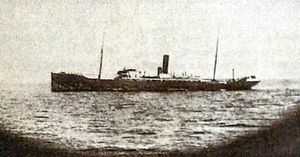Action of 16 January 1916
| Action of 16 January 1916 | |||||||
|---|---|---|---|---|---|---|---|
| Part of World War I War at Sea | |||||||
 SMS Mowe, a photo taken from SS Appam in January 1916. | |||||||
| |||||||
| Belligerents | |||||||
|
|
| ||||||
| Commanders and leaders | |||||||
| unknown |
| ||||||
| Strength | |||||||
| 1 steamer | 1 auxiliary cruiser | ||||||
| Casualties and losses | |||||||
|
18 killed, 5 wounded, ~3 captured, 1 steamer scuttled | none | ||||||
The Action of 16 January 1916 was a single ship action of World War I. It was fought between a German auxiliary cruiser and a British merchant ship off the Portuguese islands of Madeira in the Atlantic Ocean.
Background
Most successful of German commerce raiders during the war, SMS Möwe was commanded by Korvettenkapitän (corvette captain) Nikolaus zu Dohna-Schlodien and was assigned to duty in the Atlantic. Möwe was originally a freighter launched in 1914 until converted in 1915. She displaced 9,800 tons and was armed with four 150-milimeter guns, one 105-millimeter gun and two torpedo tubes. Her opponent was the one gun merchant ship, SS Clan Mactavish of Great Britain laden with fur, meat and cotton.
Action
Möwe was steaming approximately 120 miles south of Madeira on 16 January 1916, with the merchant steamer SS Appam, a vessel previously captured by the Germans who installed a prize crew and transferred several dozen prisoners of war to. At sunset, lookouts aboard Möwe sighted smoke on the horizon, a sure indication of a ship. Immediately, Kapitän Dohna-Schlodien ordered Appam to remain behind while he went to investigate. Several minutes later, at about 21:00, Möwe came within a distance to where her lookouts could make out that the smoke had originated from a large merchant ship, later identified as the 5,816 gross ton Clan Mactavish of the Clan Line company. By the time Möwe came within close range, it was dark, so the Germans approached cautiously. Using a signal lamp, Dohna-Schlodien requested the steamer's name but the British responded by asking that the Germans first identify themselves. Dohna-Schlodien signaled that his ship was the SS Author, sailing from Liverpool to Natal. Möwe reportedly looked very similar to Author, which was sunk by the Germans a few weeks earlier. Clan Mactavish then signaled her name and that they were returning to Britain from Australia.
This was the end for the merchantman, now identified as enemy, Kapitän Dohna-Schlodien crossed the steamer's bow and ordered her to halt, a signal which certainly shocked the unsuspecting Britons. Instead of stopping, the British altered course and increased speed, hoping to outrun the raider. Warning shots were fired, but they were ignored so a chase began. The one gun of the British ship, mounted on her stern, was manned and opened fire on the chasing Germans, but the shots were not well directed. Some splashed into the water near the auxiliary cruiser, but ultimately none struck the German vessel and they therefore suffered no damage or casualties in the engagement. The German sailors responded to the British with counter battery fire from their 150-millimeter guns, and for several moments the two vessels fought. Clan Mactavish fired at the pursuing Mowe, and during this she sent distress calls out which were received by the armoured cruiser HMS Essex. However, the telegraphist aboard the cruiser failed to inform his superiors of the action so no help was sent. Eventually, after taking several hits topside, the one gun Clan Mactavish began to burn and her captain signaled Möwe that they were surrendering. Möwe then maneuvered in for boarding.
All of the German rounds were hits with the exception of the warning shots. The steamer was quickly seized, prisoners removed and charges set for scuttling. Within moments of boarding, the explosives laid in Clan Mactavish were detonated and she sank to the bottom of the ocean. Eighteen British sailors were killed in battle or just after and five others were wounded. The commander of Clan Mactavish was a Royal Navy captain and her gun was manned by two navy sailors, all three were captured among dozens of civilians. At this point, the Germans now held a total of over 500 Allied prisoners of war on Möwe and SS Appam.
Aftermath
After destroying the steamer the Germans reunited with Appam and set a westward course, thus avoiding any possibility of encountering the British cruisers in the area. Two of the cruisers were just over 100 mi (87 nmi; 160 km) from the battle area that night and could have been moved to a position of intercepting the Germans had the telegraphist aboard Essex responded. Möwe went on to sink several more Allied ships before returning home. Upon arrival, Kapitän Dohna-Schlodien received an Iron Cross second class. During her second cruise, Möwe defeated another one gun steamer in an action in the mid-Atlantic in March 1917.
See also
References
Further reading
- Hoyt, Edwin P Elusive Seagull (Frewin 1970) ISBN 0-09-101570-7.